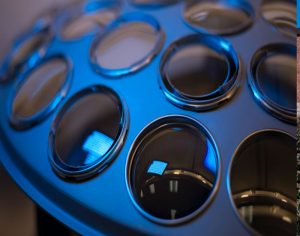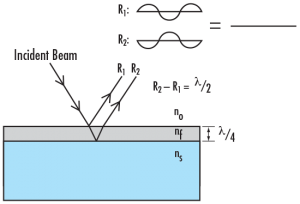

Most AR coatings are also very durable, with resistance to both physical and environmental damage. For these reasons, the vast majority of transmissive optics include some form of anti-reflection coating. When specifying an AR coating to suit your specific application, you must first be fully aware of the full spectral range of your system. While an AR coating can significantly improve the performance of an optical system, using the coating at wavelengths outside the design wavelength range could potentially decrease the performance of the system.
Due to Fresnel reflection, as light passes from air through an uncoated glass substrate approximately 4% of the light will be reflected at each interface. This results in a total transmission of only 92% of the incident light, which can be extremely detrimental in many applications. Excess reflected light reduces throughput and can lead to laser induced damage in laser applications. Anti-reflection (AR) coatings are applied to optical surfaces to increase the throughput of a system and reduce hazards caused by reflections that travel backwards through the system and create ghost images. AR coatings are especially important for systems containing multiple transmitting optical elements. Many low-light systems incorporate AR coated optics to allow for efficient use of light.
AR coatings are designed so that the relative phase shift between the beam reflected at the upper and lower boundaries of a thin film is 180°. Destructive interference between the two reflected beams occurs, which cancels out both beams before they exit the surface. The optical thickness of the optical coating must be an odd integer multiple of λ/4, where λ is the design wavelength or wavelength being optimized for peak performance in order to achieve the desired path difference of λ/2 between the reflected beams. When achieved, this it will lead to the cancellation of the beams. The index of refraction of a thin film (nf) needed for complete cancelation of the reflected beams can be found by using the refractive indices of the incident medium (n0) and the substrate (ns).
(1)nf=√n0nsnf=n0ns

AR V-coats are a type of AR coating designed to increase transmission over a very narrow waveband centered at a specified design wavelength (DWL). This coating type is called “V-coat” because the curve of the transmission versus wavelength forms a “V,” with a minimum at the DWL. V-coats are ideal for obtaining maximum transmission when using single-frequency, small linewidth lasers, or narrow full width-half max (FWHM) light sources. V-coats typically have a reflectivity of less than 0.25% at the DWL. However, the reflection curve for the coating locally has a nearly parabolic shape and the reflectivity is significantly higher at wavelengths besides the DWL .
Because reflectivity increases rapidly as the wavelength of the source moves further away from the DWL, optical components with V-coats are meant for use at exactly or very close to the intended DWL of the coating. An interesting characteristic of V-coats is that the shape of their transmission curves is semi-periodic such that the reflectivity reaches a local minimum at harmonics of the DWL (e.g. λ0/2 or λ0/4) that are not as optimized for reflectivity as at the DWL. V-coats are usually comprised of only two coating layers. Simple V-coats can consist of a single layer with a thickness of a λ/4, but more layers may be required to adjust the bandwidth or if a coating material with an appropriate index of refraction is not available. Multilayer coatings may also compensate for different angles of incidence, but are more complicated and tend to have larger bandwidths. If the thickness of the V-coat layers are incorrect, the reflectivity of the coating increases and the DWL changes. This allows for small shifts in the DWL from coating tolerances.
Broadband anti-reflection (BBAR) coatings are designed to improve transmission over a much wider waveband. They are commonly used with broad spectrum light sources and lasers with multiple-harmonic generation. BBAR coatings typically do not achieve transmission values quite as high as V-coats, but are more versatile because of their wider transmission band. In addition to being applied to transmissive optical components including lenses and windows, AR coatings are also used on laser crystals and nonlinear crystals to minimize reflections, as Fresnel reflections occur where air and the crystal meet.
λ/4 MgF2: The simplest AR coating used is λ/4 MgF2 centered at 550nm (with an index of refraction of 1.38 at 550nm). MgF2 coating is ideal for broadband use though it gives varied results depending upon the glass type involved.
VIS 0° and VIS 45°: VIS 0° (for 0° angle of incidence) and VIS 45° (for 45° angle of incidence) provide optimized transmission for 425 – 675nm, reducing average reflection to 0.4% and 0.75% respectively. VIS 0° AR coating is preferred over MgF2 for visible applications.
VIS-NIR: Our visible/near-infrared broadband anti-reflection coating is specially optimized to yield maximum transmission (>99%) in the near infrared.
Telecom-NIR: telecom/near-infrared is a specialized broadband AR coatings for popular telecommunications wavelengths from 1200 – 1600nm.
UV-AR and UV-VIS: Ultraviolet coatings are applied to our UV fused silica lenses and UV fused silica windows to increase their coating performance in the ultraviolet region.
NIR: Broadband AR coatings offer exceptional performance in near-infrared wavelengths of common fiber optics, laser diode modules and LED lights.